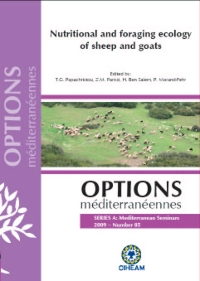| Article précédent | p. 197-199 | Article suivant |
Control of Lymantria dispar L. for eliminating the risk of forage production loss for small ruminants
Range plants that constitute the basic feed source for grazing animals are harmed due to various biological and environmental factors. The quality and quantity of kermes oak (Quercus coccifera L.), mostly preferred by small ruminants (goats) because of the high ratio of sugar to tannin content in its leaves, can be affected seriously by infestation by gipsy moth (Lymantria dispar L.). In securing the quantity and protecting the quality of kermes oak vegetation, an experiment was designed to address the gipsy moth problem. During spring 2006, 2nd instar larvae were collected from the watershed of the Migdonia area of Thessaloniki prefecture and put in cases where insecticides were applied. At the same time, the entomopathogenic nematode, Steinernema carpocapsae, which was applied for first time in Greece as a biological control against gipsy moth, was also tested. Five treatments in four replications were applied. The results from the experiment demonstrated that S. carpocapsae can be used successfully as a biological control agent against gipsy moth larvae.
Les plantes pastorales qui constituent la principale source de fourrage pour les animaux en pâturage sont menacées à cause des différents facteurs biologiques et environnementaux. La quantité et la qualité du chêne kermès (Quercus coccifera L.), préféré essentiellement par les petits ruminants (chèvres) à cause du rapport élevé sucre:tannins dans ses feuilles, peuvent être affectées par une sérieuse infestation par Lymantria dispar L. Afin de pallier ce problème, une expérience a été réalisée pour mettre en évidence l'effet de Lymantria dispar L. sur la biomasse de chêne kermès produite et sa qualité. Durant le printemps 2006, des chenilles de 2ème âge ont été prélevées et placées dans des cages entomologiques improvisées dans lesquelles cet essai a été réalisé. Des insecticides connus et déjà utilisés ont été appliqués ainsi que le nématode entomopathogène Steinernema carpocapsae, pour la première fois en Grèce, contre le L. dispar. Cinq (5) interventions x 4 répétitions ont été réalisées. Cet essai a montré que Steinernema carpocapsae peut être utilisé avec de bons résultats, contre les larves du L. dispar.
- [ Afficher ]
- [ Télécharger ]
- [ Exporter la citation ]
Vous pouvez télécharger la citation au format :
- [ Imprimer ]
-
Mots-clés
CAPRIN, ENVIRONNEMENT, GRECE, LARVE, PATURAGE, QUERCUS COCCIFERACiter cet article
Papadopoulou S., Chryssochoides C., Katanos J. Control of Lymantria dispar L. for eliminating the risk of forage production loss for small ruminants. In : Papachristou T.G. (ed.), Parissi Z.M. (ed.), Ben Salem H. (ed.), Morand-Fehr P. (ed.). Nutritional and foraging ecology of sheep and goats. Zaragoza : CIHEAM / FAO / NAGREF, 2009. p. 197-199. (Options Méditerranéennes : Série A. Séminaires Méditerranéens; n. 85). 12. Seminar on: Nutritional and Foraging Ecology of Sheep and Goats, 2007/10/11-13, Thessaloniki (Greece). http://om.ciheam.org/om/pdf/a85/00801008.pdf



